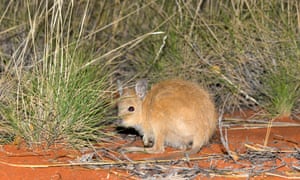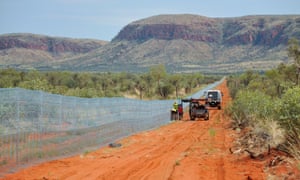Extract from The Guardian
Feral cats kill a million native birds every night and have caused extinction of 20 native species since introduction
The world’s largest cat-proof fence has been completed in central
Australia, creating a 94 square kilometre sanctuary for endangered
marsupials.
The 44km fence – made of 85,000 pickets, 400km of wire and 130km of netting – surrounds the Newhaven wildlife sanctuary, a former cattle station that has been bought by the Australian Wildlife Conservancy.
Endangered species such as the bilby, the burrowing bettong and the mala (also known as the rufous hare-wallaby) will have a chance to replenish their populations inside the massive sanctuary, safe from Australia’s feral cat epidemic.
Feral cats kill a million native birds every night across Australia and have caused the extinction of 20 native species since they were introduced by the first fleet.

The 44km fence – made of 85,000 pickets, 400km of wire and 130km of netting – surrounds the Newhaven wildlife sanctuary, a former cattle station that has been bought by the Australian Wildlife Conservancy.
Endangered species such as the bilby, the burrowing bettong and the mala (also known as the rufous hare-wallaby) will have a chance to replenish their populations inside the massive sanctuary, safe from Australia’s feral cat epidemic.
Feral cats kill a million native birds every night across Australia and have caused the extinction of 20 native species since they were introduced by the first fleet.

At a conservative estimate, AWC says cats have been killing 73,000 native mammals, reptiles and birds a year in the current fenced area in the Northern Territory.
Conservationists plan to reintroduce a total of 11 endangered marsupials into the area, after trapping and removing the estimated 50 feral cats already there with the assistance of local Warlpiri trackers.
The new species will include bilbies, numbats, golden bandicoots, western quolls and black-footed rock wallabies. Ten of the species had previously been hunted to extinction in the region.
When complete, the 94 square kilometre haven will be the largest cat-free area on mainland Australia, where feral cats cover 99.8% of the continent.

Fleming said the sanctuary would revoke central Australia’s status as “the global epicentre for mammal extinctions”, having lost about 30 species since European colonisation.
“There are lots of things being tried. Better baits, better traps and in the long term stuff like gene-drive technology. But at this point in time, there’s no silver bullet and no guarantee there will be a silver bullet. So these large feral-free areas are critical.
“When you get rid of the foxes and cats, these native mammals breed like rabbits. This is what Newhaven is all about. Even though you’re putting a fence around it, you’re doing that to recreate natural conditions. The irony is that it’s the area outside the fence is unnatural because it’s full of cats and foxes.”
Fleming said the next stage in the project was to extend the sanctuary from 94 to 700-1000 square kilometres, making the world record fence even longer.
“The second stage will be a minimum of 70,000 hectares (700 square km). It might end up bigger than that. So a minimum of another 135km of fence line.”

No comments:
Post a Comment